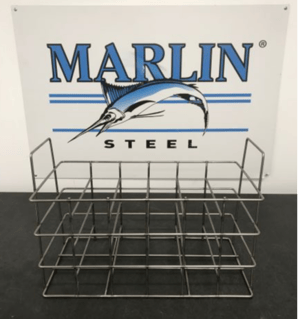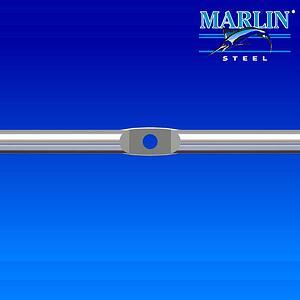 Over the years, Marlin Steel has created several tons’ worth of custom wire forms. Countless pounds of steel wire have been run through the Marlin Steel production line as hard-working wire bending robots and their operators have worked to get each piece of metal to bend in the exact right way to meet the needs of Marlin’s clients.
Over the years, Marlin Steel has created several tons’ worth of custom wire forms. Countless pounds of steel wire have been run through the Marlin Steel production line as hard-working wire bending robots and their operators have worked to get each piece of metal to bend in the exact right way to meet the needs of Marlin’s clients.
During the manufacturing process, Marlin’s production engineers have worked tirelessly to find new ways to process steel wire forms for greater efficiency so that increasingly challenging timetables can be met without compromising the quality of the final product.
Learn more about the benefits of stainless steel wire forms and why the quality of Marlin Steel wire form manufacturing is essential for meeting your performance goals.
Quick Links
- What Is Wire Forming?
- Common Materials Used in Wire Form Manufacturing
- Four Reasons For Choosing Stainless Steel Wire Forming
- Common Challenges with Custom Wire Forms
- Choose Marlin Steel For Your Custom Wire Forms
What Is Wire Forming?
Wire forming is the process of taking wire, either from a spooled coil or blank length, and bending into specific forms. Due to their flexibility, wire forms can take nearly any shape and are useful for being formed into specific configurations.
Some of the most common shapes for wire forming are springs and chains. Since wire forms can be angled, coiled, cut, or bent in all different directions, they are useful for customized projects. Wire forms can be made to form everything from tiny springs for machinery parts to large chains to carry heavy objects.
Since wire forming has a variety of uses, employing the right kind of wire forming manufacturer matters. Safety and productivity are directly affected by the quality of the wire forming products. While they may have a higher cost, higher quality materials result in greater efficiency, increased employee safety, and reduced costs from damaged equipment and inventory.
Common Materials Used in Wire Form Manufacturing
While there are numerous materials that can be used in wire forms, there are several that are especially popular for their characteristics. Some of the most common materials used in wire form manufacturing include plain, stainless, or galvanized steel. The type of material used depends on the application and exact performance needs.
Additionally, how the wire forms are constructed matters in terms of quality. By using automated manufacturing equipment, Marlin Steel is able to produce custom wire formed products with consistency and reliability unmatched by manual labor.
Four Reasons For Choosing Stainless Steel Wire Forming
Stainless steel is one of the most popular material choices for custom wire forms due to its numerous advantages for a wide variety of applications. Some of the more notable benefits include:
High-Temperature Resistance
Stainless steel tends to keep its structural integrity despite extreme temperatures. Many applications require wire forms to be exposed to high-temperature processes, such as parts sterilization or heat treating. Whereas alternatives, such as plastic, would melt, stainless steel is able to withstand harsh temperatures without the threat of harm. While there are numerous formulations of stainless steel on the market with different melting points, many can withstand hundreds of degrees of heat. Stainless steel grade 410, for example, has a temperature range of 1480-1530°C (2696-2786°F). Although high-temperature processes tend to put stress on materials, stainless steel wire forming can still be resilient even in extreme environments.
Durability
Unlike alternatives, stainless steel features unmatched durability needed for many manufacturing processes. The material boasts of high tensile strength with a high impact tolerance and scratch resistance, which makes it ideal for many uses.
Besides being more resistant to dents and gouges, stainless steel wire forming is often a popular choice for pharmaceutical and medical uses since its resistance to scratches and damage mean that stray fluids, contaminants, and bacteria cannot reside on its surface and lead to infections.
Long-lasting
Stainless steel’s structural durability means that custom steel wire forms can be repeatedly used in operations for years without replacements. Since stainless steel has high scratch resistance, it is significantly less likely to suffer from scratches, dents, and gouges which can lead damage in structural integrity. Investing in stainless steel products allows a greater ROI since steel wire forms can last for years.
Corrosion Resistant
Stainless steel wire forming is ideal for applications that involve harsh environments of caustic chemicals, such as pharmaceutical or automotive parts cleaning. Due to its highly corrosion-resistant abilities, stainless steel can be used repeatedly in corrosive solvents and chemicals, such as blood, chlorides, and sanitizing agents, and still maintain its structural integrity.
Many cleaning solutions for ultrasonic cleaning processes involve harsh chemicals with low pH levels capable of removing oil, grease, lime deposits, and oxide layers. Stainless steel wire forms made for parts cleaning are capable of withstanding extended and repeated exposure to such corrosives.
Common Challenges with Custom Wire Forms
Marlin Steel has crafted stainless steel wire forms for years and has experience with many of the production challenges posed by bending steel wire. Here’s a list of common issues in custom-shaping steel wire and how Marlin’s degreed engineers overcome them:
Piercing Steel Wire
 When manufacturing many custom wire forms, it is necessary to create a small opening in a piece of steel wire so that another object can be run through it. For example, in steel wire baskets meant to be mounted on a corkboard or peg wall, some of the wires may need to be pierced so that nails, screws, or other fastening devices can be used to attach the basket to the other surface.
When manufacturing many custom wire forms, it is necessary to create a small opening in a piece of steel wire so that another object can be run through it. For example, in steel wire baskets meant to be mounted on a corkboard or peg wall, some of the wires may need to be pierced so that nails, screws, or other fastening devices can be used to attach the basket to the other surface.
The difficulty here is that the steel wire to be pierced is typically very hard and small, requiring both careful preparation and great force to penetrate. Some steel manufacturers work around this by superheating the steel, making it more malleable and easier to puncture. However, until it is cooled appropriately, this leaves the steel wire susceptible to deformation, which can ruin the shape of the final product.
Marlin uses a high-tonnage steel press to puncture steel wire without having to heat it up first. This leaves a perfectly shaped hole in the metal without the risk of post-punch deformities that the superheating process introduces.
This same piece of automation is also used to cold-shape solid steel for flattening, swaging, and coining operations.
Making Compound Bends
In any wire shaping process, the compound bend is typically the most difficult shape to make.
A compound bend is any feature within the wire form that has two adjacent bends or generations with no straight length next to the beginning or end of those radii. In English, this means two consecutive bends made without a “break” between them.
This is because wire forming is usually done progressively, starting in a line from one end to the next. As a general rule of thumb, for any bend to begin you need at least some amount of straight wire, usually an amount equal to about 1 - 1.5 times the diameter of the wire, depending on the hardness of the metal.
However, this is just a general rule of thumb, and the possibility of making a compound bend for any specific shape will depend on how tight the bends are, the capabilities of the wire-bending equipment being used, and the skill of the operator. For example, skilled operators can cheat the system a little by using a grinder to create extra clearance between compound bends.
Shaping Stainless Steel
 Stainless steel has unique challenges compared to shaping plain steel or iron. With stainless, surface finish and quality are much more important than in plain steel, as the protective oxide layer could be compromised if the finish is damaged. Additionally, different alloys of stainless steel have different mechanical properties that influence how much spring back a particular piece of wire might experience after a bend.
Stainless steel has unique challenges compared to shaping plain steel or iron. With stainless, surface finish and quality are much more important than in plain steel, as the protective oxide layer could be compromised if the finish is damaged. Additionally, different alloys of stainless steel have different mechanical properties that influence how much spring back a particular piece of wire might experience after a bend.
Addressing this issue takes more than just excellent automated bending equipment, it takes knowledgeable production engineers who can account for the varying amounts of resistance different stainless steel alloys might require when being bent to at varying wire thicknesses.
Choose Marlin Steel For Your Custom Wire Forms
Stainless steel wire forms offer a plethora of advantages for numerous applications due to stainless steel’s unique abilities. By utilizing stainless steel wire forms, you can receive the best ROI on your products, as well as increased efficiency and productivity.
Further, the right wire forming provides you with the quality you need to meet your performance goals. With trained engineers and wire bending robots, Marlin Steel can provide you with custom wire forms specifically tailored to your individual requirements. Contact Marlin Steel today and see what custom wire forms can do for you!



.gif)


